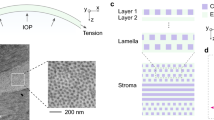Abstract
The present paper describes a calculation technique to determine a value of Young's modulus for the cornea when the intraocular pressure, the shape of the cornea and the thickness variation along the cornea are known fromin vivo measurements. Twenty-eight persons were examined in both eyes and a mean value of Young's modulus for the cornea was calculated to 2.45×104±0.57×104 N/m2 (S.D.).
Similar content being viewed by others
Literature
Andreassen, T. T., A. H. Simonsen and H. Oxlund. 1980. “Biomechanical Properties of Keratoconus and Normal Corneas.”Expl Eye Res. 31, 435–441.
Battaglioli, J. L. and R. D. Kamm. 1984. “Measurements of the Comprehensive Properties of Scleral Tissue.”Inv. Ophthal. vis. Sci. 25, 59–65.
Borcherdinging, M. S., L. J. Blacik, R. A. Stittig, J. W. Bizzell, M. Breen and H. G. Weinstein. 1975. “Proteoglycans and Collagen Fibre Organization in Human Corneoscleral Tissue.”Expl Eye Res. 21, 59–70.
Bruggemann 1968.Conic Mirrors, pp. 21–29. London: Focal Press.
Edmund, C. 1987. “Determination of the Corneal Thickness Profile.” To be published.
Eliason, J. and D. Maurice. 1981. “Stress Distribution Across thein Vivo Human Cornea.”Inv. Ophthal. vis. Sci. (Suppl. Arvo) p. 156.
Fung, Y.-C. B. (1972). “Stress-Strain-History Relations of Soft Tissues in Simple Elongation.” InBiomechanics, Its Foundation and Objectives, Y.-C. B.Fung, N. Perrone and M. Anliker (Eds), pp. 181–208. Englewood Cliffs NJ: Prentice-Hall.
Greene, P. R. and T. A. McMahon. 1979. “Scleral Creep vs Temperature and Pressurein Vitro.”Expl Eye Res. 29, 527–537.
Mandell, R. B. and R. St. Helen. 1971. “Mathematical Model of the Corneal Contour.”Br. J. physiol. Opt. 26, 183–196.
Nash, I. S., P. R. Greene and C. S. Foster. 1982. “Comparison of Mechanical Properties of Keratoconus and Normal Corneas.”Expl Eye Res. 35, 413–423.
Nyquist, G. W. 1968. “Reology of the Cornea: Experimental Techniques and Results.”Expl Eye Res. 7, 183–188.
Schwartz, N. J., R. S. Mackay and J. L. Sackman. 1966. “A Theoretical and Experimental Study of the Mechanical Behaviour of the Cornea with Application to the Measurement of the Intraocular Pressure.”Bull. math. Biol. 28, 585–643.
Sjøntoft, E. 1983. “Deconvolution When Only the Lower Order Moments of the Convolution Function are Known.”Nucl. Instrum. Meth. Phys. Res. 206, 199–202.
Townsley, M. 1970. “New Knowledge of the Corneal Contour.”Contacto 14, 38–43.
Woo, S., A. S. Kobayashi, W. A. Schlegel and C. Lawrence. 1972. “Nonlinear Material Properties of Intact Cornea and Sclera.”Expl Eye Res. 14, 29–39.
Author information
Authors and Affiliations
Rights and permissions
About this article
Cite this article
Sjøntoft, E., Edmund, C. In vivo determination of young's modulus for the human cornea. Bltn Mathcal Biology 49, 217–232 (1987). https://doi.org/10.1007/BF02459699
Received:
Revised:
Issue Date:
DOI: https://doi.org/10.1007/BF02459699




